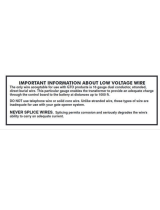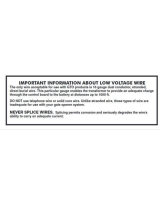
3
1. For additional connection information, refer to the
owner’s manual(s) for any component(s) connected
to the XCS200 Loudspeaker.
2. The XCS200’s built-in speaker protection incorpo-
rates three automatic resetting solid-state devices
in the crossover networks. One protects the tweet-
ers, one for the midranges and one for the woofers.
The protection allows a certain amount of over-
drive but extended periods will trigger protection.
If an obvious lack of high, mid or low frequencies
is noticed, the Protection Device may have acti-
vated. These devices will automatically reset when
the volume level is reduced significantly and kept
low until the output of the affected Loudspeaker
Element returns to normal.
3. When the XCS200 Loudspeaker System is driven
by more than one amplifier, the output levels of the
different amplifiers connected to the Loudspeaker
System must be adjusted to achieve a proper bal-
ance between the low, midrange and high frequen-
cies reproduced. This adjustment is best achieved
through the use of audio test equipment operated
by a qualified installer.
4. When discarding the unit, comply with local rules
or regulations. Batteries should never be
thrown away or incinerated but disposed
of in accordance with the local regula-
tions concerning battery disposal.
5. For additional information on the
XCS200 and other McIntosh Products
please visit the McIntosh Web Site at
www.mcintoshlabs.com.
Thank You
Please Take A Moment
Technical Assistance
If at any time you have questions about your McIntosh
product, contact your McIntosh Dealer who is familiar
with your McIntosh equipment and any other brands
that may be part of your system. If you or your Dealer
wish additional help concerning a suspected problem,
you can receive technical assistance for all McIntosh
products at:
McIntosh Laboratory, Inc.
2 Chambers Street
Binghamton, New York 13903
Phone: 607-723-1545
Fax: 607-724-0549
Customer Service
If it is determined that your McIntosh product is in
need of repair, you can return it to your Dealer. You
can also return it to the McIntosh Laboratory Service
Department. For assistance on factory repair return
procedure, contact the McIntosh Service Department
at:
McIntosh Laboratory, Inc.
2 Chambers Street
Binghamton, New York 13903
Phone: 607-723-3515
Fax: 607-723-1917
Copyright 2010 © by McIntosh Laboratory, Inc.
Table of Contents
The serial number, purchase date and McIntosh Dealer
name are important to you for possible insurance
claim or future service. The spaces below have been
provided for you to record that information:
Serial Number: _______________________________
Purchase Date: _______________________________
Dealer Name: ________________________________
General Information
Your decision to own this McIntosh XCS200 Loud-
speaker System ranks you at the very top among
discriminating music listeners. You now have “The
Best.” The McIntosh dedication to “Quality,” is as-
surance that you will receive many years of listening
enjoyment from this unit.
Please take a short time to read the information in
this manual. We want you to be as familiar as pos-
sible with all the features and functions of your new
McIntosh.
Safety Instructions ..................................................... 2
Thank You and Please Take a Moment ...................... 3
Technical Assistance and Customer Service ............. 3
Table of Contents and General Information .............. 3
Introduction ................................................................ 4
Performance Features ................................................ 5
Dimensions ................................................................ 6
Unpacking the Loudspeaker and
Installing the XCS20 using Stablilizer Bar ................ 7
Installing the XCS200 on the Wall .........................8-9
Room Acoustics and Loudspeaker Placement ......... 10
How to Connect using a single Amplifier ............... 11
How to Connect using two Amplifiers ............... 12-13
How to Connect using three Amplifiers ............. 14-15
Photos .................................................................. 16-17
Specifications ........................................................... 18
Packing Instruction .................................................. 19





















